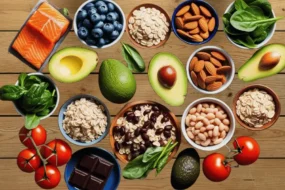
When we think of protein sources, we often focus on foods like meat, eggs, dairy, or legumes. However, did you know that some fruits also contain protein? While fruits are not primary protein sources, certain varieties contribute modestly to your daily intake. By pairing protein-rich fruits with other nutrient-dense foods, you can maintain a well-balanced diet that supports muscle health, metabolism, and overall nutrition.
In this article, we’ll explore which fruits have the highest and lowest protein content and how to incorporate them into your diet.
Which Fruit Packs the Most & Least Protein?
Guava has the most protein, with 2.6–3g per 100g, while watermelon has the least, with just 0.6g per 100g. Both offer unique health benefits beyond protein!
Which Fruit Has the Most Protein?
According to Deepalakshmi, a registered dietitian at Shree Balaji Medical Centre, Chennai, guava has the highest protein content. Compared to other fruits, it is also packed with essential nutrients.
Nutritional Profile of Guava (Per 100g):
Protein: 2.6 to 3 grams
Fiber: High in dietary fiber
Vitamins: Excellent source of vitamin C
Antioxidants: Contains beneficial plant compounds that support overall health
Health Benefits of Guava:
Supports Digestive Health: The high fiber content promotes digestion and helps prevent constipation.
Boosts Immunity: A rich source of vitamin C, guava strengthens the immune system.
Promotes Overall Well-being: Contains antioxidants that reduce inflammation and protect against diseases.
How Much Guava Should You Eat?
Consuming one medium-sized guava (approximately 150-200 grams per day) can provide 4 to 6 grams of protein, making it a great addition to a plant-based or high-protein diet.
To maximize its benefits, try eating guava:
Fresh as a snack
Blended into smoothies
Added to fruit salads
Paired with yogurt or nuts for a protein boost
Which Fruit Has the Least Protein?
At the other end of the spectrum, watermelon contains the least protein among commonly consumed fruits. While not a significant source of protein, it has other valuable health benefits.
Nutritional Profile of Watermelon (Per 100g):
Protein: 0.6 grams
Water Content: Over 90%, making it highly hydrating
Vitamins: Good source of vitamins A and C
Antioxidants: Contains lycopene, which helps reduce oxidative stress
Health Benefits of Watermelon:
Hydration: Due to its high water content, watermelon helps keep the body hydrated, especially in hot climates or after exercise.
Electrolyte Balance: Contains potassium, which helps maintain fluid balance in the body.
Supports Heart Health: Lycopene, an antioxidant in watermelon, has been linked to better heart health.
How Much Watermelon Should You Eat?
Eating 1 to 2 cups (about 200-300 grams) of watermelon daily supports hydration and provides essential vitamins and antioxidants. However, it should not be relied upon as a protein source.
To enjoy its benefits, try eating watermelon:
Freshly sliced as a snack
Blended into a refreshing juice or smoothie
Mixed with feta cheese for a sweet-savory salad
Frozen for a cooling summer treat
Conclusion
Fruits are not primary protein sources, but some contain more than others.
Guava is the highest-protein fruit, offering 2.6 to 3 grams of protein per 100 grams.
Watermelon is one of the lowest-protein fruits, containing just 0.6 grams per 100 grams.
For a well-balanced diet, complement fruit intake with high-protein foods like:
Dairy products (yogurt, cottage cheese)
Nuts and seeds (almonds, chia seeds)
Plant-based protein sources (legumes, tofu)
While fruits alone won’t provide enough protein to meet daily needs, adding high-protein fruits like guava to a diverse diet can help contribute to overall protein intake. By making smart food choices, you can enjoy both the taste and the health benefits of fruits while maintaining a balanced diet.
Would you consider adding more protein-rich fruits to your diet? Let us know in the comments!
I’m Ayesha Zahid, a certified Nutritionist and Dietitian with over 3 years of hands-on experience helping individuals and families improve their health through nutrition.




